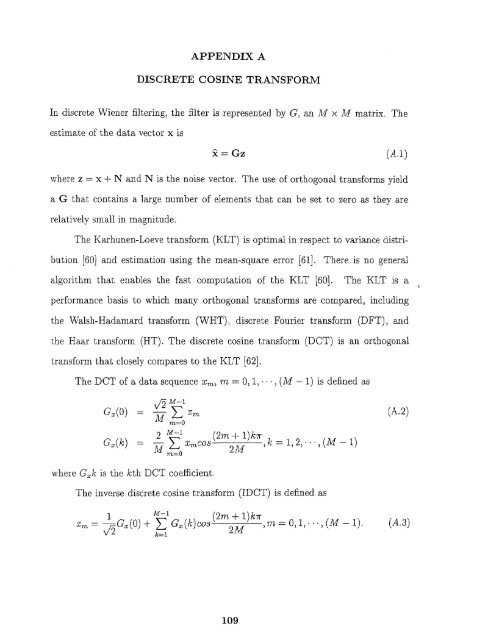- Page 1 and 2:
Copyright Warning & RestrictionsThe
- Page 3 and 4:
ABSTRACTSPACE/TIME/FREQUENCY METHOD
- Page 5 and 6:
SPACE/TIME/FREQUENCY METHODS IN ADA
- Page 7:
APPROVAL PAGESpace/Time/Frequency M
- Page 10 and 11:
ACKNOWLEDGMENTI would like to begin
- Page 12 and 13:
ChapterPage3.2.1 Non-Adaptive Beamf
- Page 14 and 15:
FigurePage2.22 Scalogram of a linea
- Page 16 and 17:
CHAPTER 1INTRODUCTIONVarious space,
- Page 18 and 19:
3the target. In this work we study
- Page 20 and 21:
5support consists of a population o
- Page 22 and 23:
7processing. This is explained by t
- Page 24 and 25:
92.1 An Overview of Synthetic Apert
- Page 26 and 27:
11Figure 2.2 SAR cross-range Dopple
- Page 28 and 29:
13Through the expression for the on
- Page 30 and 31:
15Illumination pattern onEarth's su
- Page 32 and 33:
17Figure 2.6 Time-frequency descrip
- Page 34 and 35:
19Figure 2.7 Computation of the sho
- Page 36 and 37:
21Figure 2.9 Spectrogram of a multi
- Page 38 and 39:
23where 9/ is the Hilbert transform
- Page 40 and 41:
Figure 2.11 Gabor Transform of a si
- Page 42 and 43:
272.3.3 Continuous Wavelet Transfor
- Page 44 and 45:
29Figure 2.13 Time-Frequency resolu
- Page 46 and 47:
Figure 2.14 Scalogram of a sine wav
- Page 48 and 49:
Figure 2.16 Regions of influence co
- Page 50 and 51:
Figure 2.17 WVD transform of a sine
- Page 52 and 53:
37Figure 2.18 Example of WVD cross
- Page 54 and 55:
39(a) Contour plot of the WVD of a
- Page 56 and 57:
41(a) Contour plot of the STFT of a
- Page 58 and 59:
43(a) Contour plot of the Gabor exp
- Page 60 and 61:
452.5 Time-Frequency Analysis in No
- Page 62 and 63:
47Consequently, when the slope S, i
- Page 64 and 65:
49where:Doppler phase shift due to
- Page 66 and 67:
51(a) Contour plotFigure 2.24 SAR i
- Page 68 and 69:
53(a) Contour plotFigure 2.26 SAR i
- Page 70 and 71:
55calculated in each case. In this
- Page 72 and 73:
57(a) Moving target with synthetic
- Page 74 and 75: Figure 2.31 SAR with 2 moving targe
- Page 76 and 77: 61Figure 3.1 Space-time adaptive ar
- Page 78 and 79: 63Figure 3.3 Airborne radar basic g
- Page 80 and 81: subspace is formed using the remain
- Page 82 and 83: 67where k is a gain constant and R
- Page 84 and 85: 69The scalar beamformed noise estim
- Page 86 and 87: 71are the desired signal, interfere
- Page 88 and 89: CHAPTER 4REDUCED-RANK PROCESSINGThe
- Page 90 and 91: 75Figure 4.2 Reduced-rank GSCThis m
- Page 92 and 93: 77This relation establishes an equi
- Page 94 and 95: 79The conditioned SNR is a random v
- Page 96 and 97: 81The performance of the GSC proces
- Page 98 and 99: 83For large interference eigenvalue
- Page 100 and 101: 85the steering vector s, and the ve
- Page 102 and 103: 87(a) CSNR vs Rank order for other
- Page 104 and 105: 89Figure 5.4 CSNR vs Rank order for
- Page 106 and 107: 91Figure 5.6 Theoretical and simula
- Page 108 and 109: 93Figure 5.8 CSNR vs CNRThe signal
- Page 110 and 111: 950.80.80.6 0.6~(5'0.4IC!J0.40.20.2
- Page 112 and 113: 97the spatial domain. The target is
- Page 114 and 115: 99(a) Training outside the target r
- Page 116 and 117: 101(a) Training around the target r
- Page 118 and 119: 103Figure 5.15 Angle scan with the
- Page 120 and 121: CHAPTER 6CONCLUSIONSThis work has b
- Page 122 and 123: 107also presented. The Sample Matri
- Page 126 and 127: 111This matrix is formed using the
- Page 128 and 129: REFERENCES1. Leon Cohen. Time-frequ
- Page 130 and 131: 11523. Franz Hlawatsch and G. Faye
- Page 132 and 133: 11750. Daniel F. Marshall. A two st
- Page 134 and 135: INDEXanalytic signal, 21array imper
















